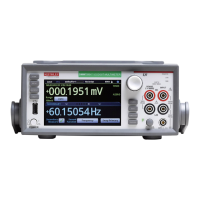3: Functions and features Model DMM7510 7½ Digit Graphical Sampling Multimeter
3-70 DMM7510-901-01 Rev. B / May 2015
Generate LXI trigger packets
You can configure the Model DMM7510 to output an LXI trigger packet to other LXI instruments.
To generate LXI trigger packets:
1. Call the SCPI :TRIGger:LAN<n>:OUT:CONNect:STATe command or TSP
trigger.lanout[N].connect() function.
2. Select the event that triggers the outgoing LXI trigger packet by assigning the specific event to
the LAN stimulus input using the SCPI :TRIGger:LAN<n>:OUT:STIMulus command or TSP
trigger.lanout[N].stimulus attribute.
Make sure to use the same LXI domain on both the Model DMM7510 instrument and the other
instrument. If the Model DMM7510 has a different LXI domain from the instrument at the other end of
the trigger connection, the LXI trigger packets are ignored by both instruments.
Trigger timers
You can use trigger timers to add delays and start measurements at timed intervals. The Model
DMM7510 has four independent timers that you can use.
Trigger timers are only available over a remote interface. You can set the count, delay, and when the
trigger occurs for the trigger timers. You need to enable the trigger timers before using the SCPI
:TRIGger:TIMer<n>:STATe or the TSP trigger.timer[N].enable command.
Count
The count sets the number of events to generate each time the timer generates a trigger event. Each
event is separated by the delay set by the SCPI :TRIGger:TIMer<n>:DELay or TSP
trigger.timer[N].delay command.
To configure the count, use the SCPI command :TRIGger:TIMer<n>:COUNt or the TSP command
trigger.timer[N].count.
If count is set to a number greater than 1, the timer automatically starts the next trigger timer delay
at the expiration of the previous delay.
Set count to zero (0) to cause the timer to generate trigger events indefinitely.
If you use the trigger timer with a trigger model, make sure the count value is the same or more than
any count values expected in the trigger model.
Timer delays
You can set up the timers to perform delays. A delay is the period after the timer is triggered and
before the timer generates a trigger event. All delay values are specified in seconds.
Delay lists, which are only available through TSP, allow the timer to sequence through an array of
delay values. Delay lists allow the timer to use a different interval each time it performs a delay. Each
time the timer generates a trigger event, it uses the next delay in the list. The timer repeats the delay
list after all of the elements in the delay list have been used.

